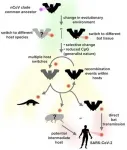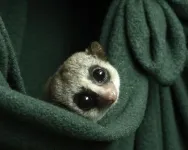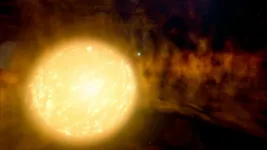(Press-News.org) New research led by the University of Cambridge has found rare evidence - preserved in the chemistry of ancient rocks from Greenland - which tells of a time when Earth was almost entirely molten.
The study, published in the journal Science Advances, yields information on a important period in our planet's formation, when a deep sea of incandescent magma stretched across Earth's surface and extended hundreds of kilometres into its interior.
It is the gradual cooling and crystallisation of this 'magma ocean' that set the chemistry of Earth's interior - a defining stage in the assembly of our planet's structure and the formation of our early atmosphere.
Scientists know that catastrophic impacts during the formation of the Earth and Moon would have generated enough energy to melt our planet's interior. But we don't know much about this distant and fiery phase of Earth's history because tectonic processes have recycled almost all rocks older than 4 billion years.
Now researchers have found the chemical remnants of the magma ocean in 3.6-billion-year-old rocks from southwestern Greenland.
The findings support the long-held theory that Earth was once almost entirely molten and provide a window into a time when the planet started to solidify and develop the chemistry that now governs its internal structure. The research suggests that other rocks on Earth's surface may also preserve evidence of ancient magma oceans.
"There are few opportunities to get geological constraints on the events in the first billion years of Earth's history. It's astonishing that we can even hold these rocks in our hands - let alone get so much detail about the early history of our planet," said lead author Dr Helen Williams, from Cambridge's Department of Earth Sciences.
The study brings forensic chemical analysis together with thermodynamic modelling in search of the primeval origins of the Greenland rocks, and how they got to the surface.
At first glance, the rocks that make up Greenland's Isua supracrustal belt look just like any modern basalt you'd find on the sea floor. But this outcrop, which was first described in the 1960s, is the oldest exposure of rocks on Earth. It is known to contain the earliest evidence of microbial life and plate tectonics.
The new research shows that the Isua rocks also preserve rare evidence which even predates plate tectonics - the residues of some of the crystals left behind as that magma ocean cooled.
"It was a combination of some new chemical analyses we did and the previously published data that flagged to us that the Isua rocks might contain traces of ancient material. The hafnium and neodymium isotopes were really tantalizing, because those isotope systems are very hard to modify - so we had to look at their chemistry in more detail," said co-author Dr Hanika Rizo, from Carleton University.
Iron isotopic systematics confirmed to Williams and the team that the Isua rocks were derived from parts of the Earth's interior that formed as a consequence of magma ocean crystallisation.
Most of this primeval rock has been mixed up by convection in the mantle, but scientists think that some isolated zones deep at the mantle-core boundary - ancient crystal graveyards - may have remained undisturbed for billions of years.
It's the relics of these crystal graveyards that Williams and her colleagues observed in the Isua rock chemistry. "Those samples with the iron fingerprint also have a tungsten anomaly - a signature of Earth's formation - which makes us think that their origin can be traced back to these primeval crystals," said Williams.
But how did these signals from the deep mantle find their way up to the surface? Their isotopic makeup shows they were not just funnelled up from melting at the core-mantle boundary. Their journey was more circuitous, involving several stages of crystallization and remelting - a kind of distillation process. The mix of ancient crystals and magma would have first migrated to the upper mantle, where it was churned up to create a 'marble cake' of rocks from different depths. Later melting of that hybrid of rocks is what produced the magma which fed this part of Greenland.
The team's findings suggest that modern hotspot volcanoes, which are thought to have formed relatively recently, may actually be influenced by ancient processes.
"The geochemical signals we report in the Greenland rocks bear similarities to rocks erupted from hotspot volcanoes like Hawaii - something we are interested in is whether they might also be tapping into the depths and accessing regions of the interior usually beyond our reach," said Dr Oliver Shorttle, who is jointly based at Cambridge's Department of Earth Sciences and Institute of Astronomy.
The team's findings came out of a project funded by Deep Volatiles, a NERC-funded 5-year research programme. They now plan to continue their quest to understand the magma ocean by widening their search for clues in ancient rocks and experimentally modelling isotopic fractionation in the lower mantle.
"We've been able to unpick what one part of our planet's interior was doing billions of years ago, but to fill in the picture further we must keep searching for more chemical clues in ancient rocks," said co-author Dr Simon Matthews from the University of Iceland.
Scientists have often been reluctant to look for chemical evidence of these ancient events. "The evidence is often altered by the course of time. But the fact we found what we did suggests that the chemistry of other ancient rocks may yield further insights into the Earth's formation and evolution - and that's immensely exciting," said Williams.
INFORMATION:
As the driver of global atmospheric and ocean circulation, the tropics play a central role in understanding past and future climate change. Both global climate simulations and worldwide ocean temperature reconstructions indicate that the cooling in the tropics during the last cold period, which began about 115,000 years ago, was much weaker than in the temperate zone and the polar regions. The extent to which this general statement also applies to the tropical high mountains of Eastern Africa and elsewhere is, however, doubted on the basis of palaeoclimatic, geological and ecological studies at high elevations.
A research team led by Alexander Groos, Heinz Veit (both from the Institute of Geography) and Naki Akçar (Institute of Geological Sciences) at the University ...
How much did SARS-CoV-2 need to change in order to adapt to its new human host? In a research article published in the open access journal PLOS Biology Oscar MacLean, Spyros Lytras at the University of Glasgow, and colleagues, show that since December 2019 and for the first 11 months of the SARS-CoV-2 pandemic there has been very little 'important' genetic change observed in the hundreds of thousands of sequenced virus genomes.
The study is a collaboration between researchers in the UK, US and Belgium. The lead authors Prof David L Robertson (at the MRC-University of Glasgow Centre for Virus Research, Scotland) ...
Informing how COVID-19 response plans may incorporate digital contact tracing, a model of COVID-19 spread within a simulated French population found that if about 20% of the population adopted a contact tracing app on their smartphones, an outbreak could be reduced by about 35%. If more than 30% of the population adopted the app, the epidemic could be suppressed to manageable levels. Jesús Moreno López and colleagues note that the effectiveness of digital contact tracing would depend on a given population's level of immunity to the virus; the intervention alone would be unable to suppress a COVID-19 epidemic where transmission - and especially asymptomatic transmission - remains high. While many countries have implemented ...
DURHAM, N.C. -- If you binged on high-calorie snacks and then spent the winter crashed on the couch in a months-long food coma, you'd likely wake up worse for wear. Unless you happen to be a fat-tailed dwarf lemur.
This squirrel-sized primate lives in the forests of Madagascar, where it spends up to seven months each year mostly motionless and chilling, using the minimum energy necessary to withstand the winter. While zonked, it lives off of fat stored in its tail.
Animals that hibernate in the wild rarely do so in zoos and sanctuaries, with their climate controls and ...
Decades of feminist gains in the workforce have been undermined by the COVID-19 pandemic, which has upended public education across the United States, a critical infrastructure of care that parents -- especially mothers -- depend on to work, according to new research from Washington University in St. Louis.
The research, published in Gender & Society, draws on new data from the Elementary School Operating Status (ESOS) database to show that the gender gap between mothers and fathers in the labor force has grown significantly since the onset of the pandemic in states where schools primarily offered remote instruction.
And if these circumstances continue, it could deliver ...
Sound sleep plays a critical role in healing traumatic brain injury, a new study of military veterans suggests.
The study, published in the Journal of Neurotrauma, used a new technique involving magnetic resonance imaging developed at Oregon Health & Science University. Researchers used MRI to evaluate the enlargement of perivascular spaces that surround blood vessels in the brain. Enlargement of these spaces occurs in aging and is associated with the development of dementia.
Among veterans in the study, those who slept poorly had more evidence of these enlarged spaces and more post-concussive symptoms.
"This has huge implications for the armed forces as well as civilians," said lead author Juan Piantino, M.D., MCR, assistant professor of pediatrics (neurology) in the ...
Astronomers have painted their best picture yet of an RV Tauri variable, a rare type of stellar binary where two stars - one approaching the end of its life - orbit within a sprawling disk of dust. Their 130-year dataset spans the widest range of light yet collected for one of these systems, from radio to X-rays.
"There are only about 300 known RV Tauri variables in the Milky Way galaxy," said Laura Vega, a recent doctoral recipient at Vanderbilt University in Nashville, Tennessee. "We focused our study on the second brightest, named U Monocerotis, which is now the first of these systems from which X-rays have been detected."
A paper describing the findings, led by Vega, was published in The Astrophysical Journal.
The system, called U ...
Water is perhaps Earth's most critical natural resource. Given increasing demand and increasingly stretched water resources, scientists are pursuing more innovative ways to use and reuse existing water, as well as to design new materials to improve water purification methods. Synthetically created semi-permeable polymer membranes used for contaminant solute removal can provide a level of advanced treatment and improve the energy efficiency of treating water; however, existing knowledge gaps are limiting transformative advances in membrane technology. One basic problem is ...
BOSTON -- SARS-CoV-2, the virus that causes COVID-19, has mutated throughout the pandemic. New variants of the virus have arisen throughout the world, including variants that might possess increased ability to spread or evade the immune system. Such variants have been identified in California, Denmark, the U.K., South Africa and Brazil/Japan. Understanding how well the COVID-19 vaccines work against these variants is vital in the efforts to stop the global pandemic, and is the subject of new research from the Ragon Institute of MGH, MIT and Harvard and Massachusetts General Hospital.
In a study recently published in Cell, Ragon Core Member Alejandro Balazs, PhD, found that the neutralizing antibodies induced by the ...
Orono, Maine -- The origins of ice age climate changes may lie in the Southern Hemisphere, where interactions among the westerly wind system, the Southern Ocean and the tropical Pacific can trigger rapid, global changes in atmospheric temperature, according to an international research team led by the University of Maine.
The mechanism, dubbed the Zealandia Switch, relates to the general position of the Southern Hemisphere westerly wind belt -- the strongest wind system on Earth -- and the continental platforms of the southwest Pacific Ocean, and their control on ocean currents. Shifts in the latitude of the westerly winds affects the strength ...





